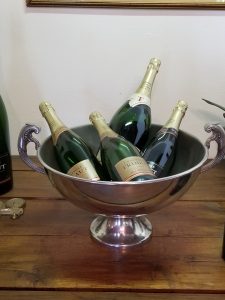With thousands of Champagnes to choose from, wine tasting in that region may feel overwhelming. Where do you start? How many can you taste? Should you stick with Champagnes that you know or be adventurous and try a few glasses from producers unknown to you? Can you really tell one from another, especially by the end of the day?
Let’s start with the best news: there are better Champagnes but there are no bad ones. To paraphrase Mae West, when Champagne is good it’s great and when it’s bad it’s still good. There is so much to learn when wine tasting in Champagne, and we’d like to start you off with a few tips.
- Don’t try to do too much at one time. Champagne is a pretty big place so don’t try to drive all over in an attempt to see it all. You will fail and you’ll lose a lot of time driving around. It’s best to focus on one place at a time. So a day in Reims can include Taittinger, Mumms and Veuve Cliquot, plus time for lunch and the cathedral. A day in Épernay (Moët & Chandon, Perrier-Jouët and lots of less well-known houses) must include a stroll down the Avenue de Champagne. And it’s a good idea to devote a day to visiting some Champagne houses out in the countryside.
- Take a tour. Very few Champagne houses offer you the chance to watch their wines being made. They do tour you around their cellars, where they store and age their wines. There they will explain the wine making process that makes sparkling wines unique. But quite honestly, if you’ve seen one cave, you’ve seen them all: long holes in the ground with a lot of bottles in them. It’s a good experience to see a Champagne cellar.
- Take advantage of the smaller Champagne houses. The big ones often aren’t open to the public at all and if they are, a tour plus tasting can be expensive. And you rarely get to taste their top wines. Especially in the larger towns, you can walk in, order a glass of Champagne (even their best) for 10 euros or less and sit in a pleasant courtyard enjoying it. Out in the country, you can do the same thing but you’ll look at the vineyards while you sip.
- Do some comparison tasting. There are many bars where you can order a variety of Champagnes. In general, they tend to have the smaller producers although we have tasted Moët & Chandon and Pol Roger side by side. There are so many comparisons to be made that you can, for instance hone your appreciation of Blanc de Noirs or contrast those with Blanc de Blancs. And you don’t have to get behind a wheel to try several different Champagnes, you just walk around.
- All the rules for managing alcohol apply in Champagne as much as anywhere else. (However, the alcohol levels in Champagne tend to be lower, so you can have a bit more freedom.) You need to put some food in your stomach. In almost every restaurant, you can get champagne by the glass with your meal.

